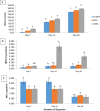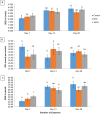Oxidative stress responses as a marker of toxicity in mice exposed to polluted groundwater from an automobile junk market in South-Western Nigeria
- PMID: 36322346
- PMCID: PMC9672174
- DOI: 10.1007/s12192-022-01305-w
Oxidative stress responses as a marker of toxicity in mice exposed to polluted groundwater from an automobile junk market in South-Western Nigeria
Abstract
The global trade in used vehicles and their components generates huge financial benefits but leads to detrimental environmental consequences including groundwater pollution and potential adverse health effects mediated by free-radical processes such as lipid peroxidation. We investigated oxidative stress responses in thirty-six, female mice orally exposed (via drinking) to graded concentrations (0%, 50%, and 100%) of groundwater from a well located within a major automobile junk market in SW-Nigeria containing extremely high levels of arsenic (0.332 ± 0.089 mg/l) and seventeen PAHs, which serves as domestic water supply. Blood samples from the mice were assayed for selected biochemical parameters at intervals of 7, 14, and 28 days. A significant dose- and duration-dependent increase in malondialdehyde (MDA) and Myeloperoxidase (MPO) confirmed oxidative stress onset due to exposure to the polluted well-water, while a significant decline in nitric oxide (NO-) levels may suggest impaired endothelial smooth-muscle relaxation which may lead to the development of metabolic diseases over time. Superoxide dismutase (SOD) and reduced glutathione (GSH) showed a contrasting trend with Glutathione peroxidase (GPx), while Glutathione-S-Transferase (GST) declined significantly by the 28th day. Two clusters were identified by principal component analysis-one involving MDA, SOD, and GSH suggesting that antioxidant responses driven mainly by SOD and GSH proved insufficient in scavenging the free radicals generated by lipid peroxidation. NO- and total protein clustered together possibly due to the significant declines in both over the study period. Histological examination of liver tissue of exposed mice corroborated the above findings and highlights the need for urgent remedial action.
Keywords: Anti-oxidants; Automobile junk; Groundwater; Mice; Oxidative stress; Toxicity.
© 2022. The Author(s), under exclusive licence to Cell Stress Society International.
Conflict of interest statement
The authors declare no competing interests.
Figures







Similar articles
-
Induction of oxidative stress in erythrocytes of male rats subchronically exposed to a mixture of eight metals found as groundwater contaminants in different parts of India.Arch Environ Contam Toxicol. 2007 Jan;52(1):145-51. doi: 10.1007/s00244-006-0053-z. Epub 2006 Oct 9. Arch Environ Contam Toxicol. 2007. PMID: 17031751
-
Antioxidant responses of peanut roots exposed to realistic groundwater doses of arsenate: Identification of glutathione S-transferase as a suitable biomarker for metalloid toxicity.Chemosphere. 2017 Aug;181:551-561. doi: 10.1016/j.chemosphere.2017.04.104. Epub 2017 Apr 24. Chemosphere. 2017. PMID: 28463730
-
Bioaccumulation, cytotoxicity and oxidative stress of the acute exposure selenium in Oreochromis mossambicus.Ecotoxicol Environ Saf. 2018 Oct 30;162:147-159. doi: 10.1016/j.ecoenv.2018.06.070. Epub 2018 Jul 11. Ecotoxicol Environ Saf. 2018. PMID: 29990726
-
Biochemical responses in the gills of Meretrix meretrix after exposure to treated municipal effluent.Ecotoxicol Environ Saf. 2015 Jan;111:78-85. doi: 10.1016/j.ecoenv.2014.09.038. Epub 2014 Oct 17. Ecotoxicol Environ Saf. 2015. PMID: 25450918
-
Effect of melatonin supplementation on oxidative stress parameters: A systematic review and meta-analysis.Pharmacol Res. 2020 Nov;161:105210. doi: 10.1016/j.phrs.2020.105210. Epub 2020 Sep 29. Pharmacol Res. 2020. PMID: 33007423
References
-
- [APHA] American Public Health Association (2005) Standard methods for the examination of water and wastewater. 21st Edition, American Public Health Association/American Water Works Association/Water Environment Federation, Washington DC
-
- Abdel-Shafy HI, Mansour MSM. A review on polycyclic aromatic hydrocarbons: source, environmental impact, effect on human health and remediation. Egypt J Pet. 2016;25:107–123. doi: 10.1016/j.ejpe.2015.03.011. - DOI
-
- Abdul Zali M, Wan Ahmad WK, Retnam A, Catrina NG. Concentration of heavy metals in virgin, used, recovered and waste oil: a spectroscopic study. Procedia Environ Sci. 2015;30:201–204. doi: 10.1016/j.proenv.2015.10.036. - DOI
MeSH terms
Substances
LinkOut - more resources
Full Text Sources
Research Materials
Miscellaneous

